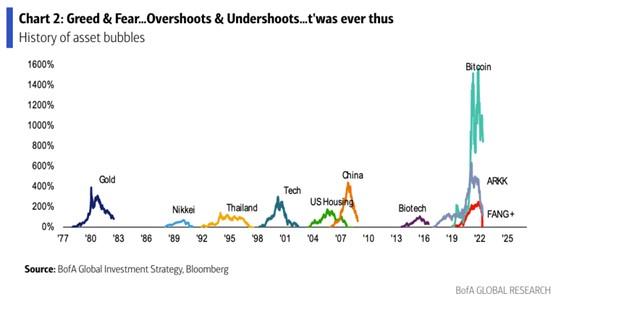Will The Dotcom Bubble Repeat Itself In The World Of Cryptocurrencies?
One Of The Most Important Economic And Technological Developments Of The Last Hundred Years Was The Dot-Com Bubble That Happened Between 1995 And 2000.
An economic bubble during which the stock market of industrialized countries had significant financial growth in which the Internet and related technologies played an essential role in this field.
One of the main characteristics of this period was the formation of various companies based on the Internet, and a wide range of them went bankrupt.
If you talk to Wall Street bigwigs, most of them remember the dot-com crash; now it seems the stock market is about to experience another déjà vu, except this time, digital currencies are going to make life miserable for a lot of people. At the beginning of June, the digital currency market experienced a bad crash, with $200 billion of investors’ assets lost in just 24 hours.
In an article on the Fortune website, Marco Queiroz-Gutierrez mentioned that rising inflation, rising interest rates, and geopolitical instability hurt the digital currency market.
Gates is not the only rich person to stay away from digital currencies.
Berkshire Hathaway CEO Warren Buffett and Vice Chairman Charlie Munger took turns criticizing Bitcoin and cryptocurrencies at the company’s annual shareholder meeting in Omaha, Neb., in late April. These people believe that digital currencies will not only destroy people’s lives but also have the capacity to bring countries’ economies to the brink of instability and create another dot-com bubble.
The S&P 500 Index, known as the Standard and Poor’s Index, has fallen 19 percent since the beginning of the year, while the Nasdaq Index, known as one of the old indices of the US stock market, has fared worse, falling more than 28 percent.
Looking at historical trends, we realize that we may be only halfway down the stock market. The dot-com recession caused many technology companies to quit in the 1990s. For example, between March 2000 and October 2002, the Nasdaq-100 fell nearly 78 percent, sending once-popular and profitable technology companies into a tailspin.
It seems that history is repeating itself, and another notable trend has emerged in the economic market that there was no sign of in the last few decades. This emerging market is digital currencies. Crypto market or cryptocurrencies In one of its worst periods, it has lost almost $1 trillion by mid-2022. Figure 1 shows the giant bubbles formed in different periods and their fluctuations.

figure 1
This dramatic decline in risky assets has fueled some of the world’s most prominent investors, including Jeremy Grantham and Scott Meinard. They have declared that the dot-com bubble is emerging. They say: “The performance of some outstanding shareholders and investors has not changed much in the last two decades, and they continue to disrupt the economy based on the speculative model of the market. This issue has caused the stock market and digital currencies to become volatile.
“There’s a lot of similarity between the dot-com bust and the bear market we’re seeing today,” George Ball, president of Sanders-Morris Harris, a $4.9 billion investment firm based in Houston, told Fortune. Do you think small and large investors have learned from the events of 2000? I don’t think so. The same events will be repeated once again on a much larger scale. What followed after the dot-com bubble burst was a brief but painful recession. It seems that now the financial markets are moving in this direction.
Another growth in profit times
Former Fed Chair Alan Greenspan describes dot-com investors and markets as “irrationally passionate” that the 2010s were the origin of this group of people and markets.
Statistics show that in every period of economic growth, the highest stock value belongs to growth-focused companies. The common point of both periods is the expectation of investors to earn profits beyond the expected limit. This issue has caused us to see a flood of small investors who put all their savings in one basket, hoping to receive an unexpected profit.
A worthy example in this field is Priceline. In 1999, the online travel agency became an overnight success and went public just a year after its founding. The company spent millions of dollars on advertising and used famous figures such as William Shatner, the star of the Star Trek series, to promote its business goals. Still, in a brief period, it experienced a loss of $142 million; however, surprisingly, this considerable loss did not matter to the investors.
All they wanted was the rapid growth of a company that would make a significant change and transforms travel agencies from their traditional style to a modern one. Shares rose from a base price of $96 to around $1,000, but when the market shook, the company’s shares fell 99%, eventually reaching $6.60 by October 2002. Just like what happened to Luna.
Let’s move forward a bit and examine the performance of Peloton.
This manufacturer of exercise bikes became one of the most profitable businesses during the pandemic. So that the shares of this company increased by more than 600% from March to December 2020 while experiencing continuous losses. In the end, the company’s stock plummeted and lost more than 90% of its value, although one of the reasons the company’s stock plummeted was that investors thought the company wasn’t worth $50 billion.
According to Ball, it’s clear that investors in both the dot-com era and today are willing to spend more to make more money, and some are willing to invest in business models that have yet to prove they can pay consistent returns.
He says: “In the dot-com era and in the current market, which is very volatile and sometimes has a spectacular growth and suddenly its value is reduced to less than half, there is a belief that investing in specific technologies and markets will always be profitable, just like the developments that Bitcoin is experiencing. Of course, this argument has no scientific or precise calculation and is not based on logic.
Most investors hope that a market’s high growth will increase their profits.
In the past, such a dangerous attitude caused many people to lose capital, and the market crashed. Now we see that history is repeating itself once again.
Dr. Brian Rutledge, associate professor of finance at Carnegie Mellon University, told Fortune in this regard: “The dot-com boom ultimately paved the way for new business models to be proven, and we may be experiencing something similar today.”
The current era is very similar to the dot-com era. In bear markets and recessions, you see that some untested ideas are introduced into the real world; therefore, fewer experts will be able to predict the results. Unfortunately, most companies disappeared forever at that time due to the lack of an efficient model and mechanism.
Stocks from the world of technology and cryptocurrency: the rise of dot-com 2.0
In the run-up to the dot-com bubble, it seemed that any company that added “.com” as an extension to its brand name would quickly find success, and terms like “crypto” and “FiFi” seem to have such a role in recent years.
Suppose you search for these two words in English or Farsi. In that case, you will come across thousands of sites, companies, and experts who cover the news of the world of cryptocurrencies, have published articles related to how to trade in these markets, and encourage people to enter these markets. And some play the role of intermediaries that connect people to foreign markets.
Extensive media coverage has caused investors to flock to these new technologies. The logic, then and now, goes like this: “Something is growing fast. It will always grow at a breakneck pace, so we should not neglect and ride this wave.”
“Inexperienced people with minimal technical knowledge are quickly attracted to the slogans that some companies use in their advertising,” says Ball. They are told to use leverage (a term in the stock market world) and pull it up to get the most profit; when the blinds come down, a sharp fall appears. This rule is also valid in connection with the technology-oriented stock market or, more precisely, digital currencies.
As you may know, the digital currency market is quite volatile, and a digital currency may turn to ashes in the blink of an eye.
The similarities between these two periods have made Ball worry that there will be various problems for investors after the fall in the value of cryptocurrencies such as Bitcoin, Luna, and similar examples.
“People don’t want to accept that psychology has the biggest impact on stock prices,” says Ball. Psychology is used reversely to gain profit by a particular group of people in the society to attract people’s capital in areas such as digital currencies. I expect the Nasdaq will probably fall below $10,000 this year, or about 12%, but no one knows how steep the fall will be.
Usually, most people act in such a way that whenever the shares of a company or an asset start to grow, they test their luck and start buying stocks to see how long this growth will continue or, conversely, when the store goes up. They are on the slope of falling.”
However, not everyone is so pessimistic about the future of stocks that the tech world has in store for users. Liz Ann Saunders, the chief strategist at Charles Schwab Investments, points out:
“The technology world’s price-to-earnings ratio and the S&P 500 is not in the same situation as the dot-com crash.
Even the all-important cyclically adjusted Price-o-Earnings ratio, known as the Shiller PE ratio, did not reach dot-com levels at the peak of the stock and price rally in 2021.”
Wedbush’s Dan Ives said: “In short, we don’t think the current situation is a dot-com bubble. “There will be a lot of players in the technology and investment space that will either exit or consolidate, but we pick the winners from our perspective.” Ives has called the recent downturn in technology a “generational buying opportunity.” However, some market experts advise people to tread cautiously.
last word
The situation that prevailed in the dot-com world still exists today, and it may surprisingly happen again. Mark Twain said: “It is futile to prevent history from repeating itself because human nature is such that it is impossible to avoid repetition.” In other words, history will repeat itself.
Jeremy Grantham, co-founder and investment strategist at Grantham, Mayo, & Van Otterloo, a Boston-based asset management firm, highlighted the macroeconomic differences between the dot-com era and today’s markets in an interview with CNBC. He says:
“The recent collapse of technology-based asset stocks may be similar to what we saw in 2000, but the destructive effect on the world economy is worse than believed. What worries me is that the new era has some significant differences from 2000.
First, the destructive impact of the 2000 dot-com boom was unique to the United States, with excellent bonds, high-yield schemes, and cheap housing. More precisely, the events of 2000 were simple and insignificant compared to the current situation. This time, the scope of events will be beyond the United States.
The legendary investor adds that today’s bond market is at an all-time low.
In addition, the prices of energy carriers, metals, and food are increasing, and the housing market is showing signs of severe recession, which could cause serious economic problems. “The thing you should never do in a bubble is mess up the housing market,” says Grantham.
When financial problems occur and to deal with inflation, governments follow different policies. Some governments will raise interest rates, which may not be good news for major stock markets. Experts in the field of economy say: “The recent fall of stocks related to the world of technology will not be the leading cause of the economic recession like in 2000.












